Research Reports / Rapports de recherche
Directory of Canadian Manufacturers, Bicycle Industry, 1880-1984
1 During the summer of 1984, the National Museum of Science and Technology (N.M.S.T.) conducted a seventeen-week research project to suggest directions for developing the Museum's bicycle collection, enhance documentation of the existing collections, and gather information for proposed travelling and permanent exhibits. Employment and Immigration Canada's Career Oriented Summer Employment Program provided financial support for the project. The bulk of the research was conducted in Toronto, where most manufacturing has been centred and strong research collections are available.
2 A wide range of resources was used. The entire run of Canadian Trade Index (C.T.I.), from 1900 to 1984, and The Might Directory Company's Toronto City Directory (T.C.D.), from 1880 to 1984, were consulted to identify manufacturers and obtain basic information about the companies. Recent miscellaneous sporting goods, provincial, and regional directories supplemented this material by indicating small, specialized manufacturers. Cycling magazines from both boom periods, the 1890s and the 1970s, and business magazines from the 1890s and early 1900s provided advertisements and articles about manufacturers and products. The information on turn-of-the-century companies found in the business periodicals was balanced by a significant number of recent newspaper and periodical articles dealing with current industry conditions. These articles were located through Canadian Periodical Index, Canadian Business Periodical Index, and Canadian Newspaper Index.
3 Certain government publications were helpful. From 1927 to 1959, the Dominion Bureau of Statistics (DBS) issued brief annual surveys of Canadian bicycle imports and domestic production. In addition to providing statistical data, the DBS literature named the year's major manufacturers and cited the aggregate number of employees in the industry. Dates of incorporation were obtained from microfiche listings of incorporated bodies produced by Consumer and Corporate Affairs Canada and the Ontario Ministry of Consumer and Commercial Relations. The fiche of companies incorporated in Ontario noted both current and dissolved historical corporations; the fiche of federally incorporated companies gave only active or recently dissolved corporations.
4 Finally, archival and artifactual evidence was consulted. The Public Archives of Canada and the Archives of Ontario had no useful material in their manuscript or photograph collections. The Massey-Ferguson archives, on the other hand, included four catalogues, a photograph, and several clippings and miscellaneous pieces of ephemera related to Massey-Harris bicycles. The N.M.S.T. artifact and catalogue collections were major resources; the Museum's collection of over 100 bicycles and its substantial holdings of catalogues, cycling books, and cycling periodicals constitutes the largest resource of its kind in Canada.
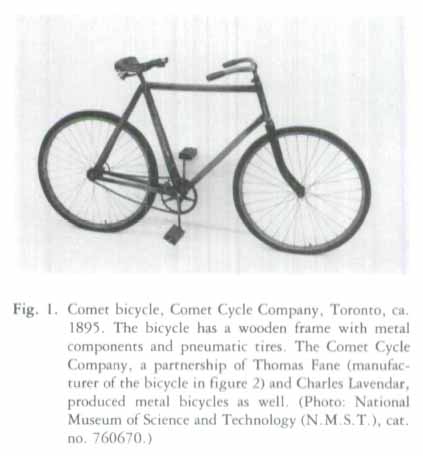 Display large image of Figure 1
Display large image of Figure 15 The sporting goods magazines had the major disadvantage of not distinguishing between distributors and manufacturers. Lists of exhibitors at recent Canadian Sporting Goods Association trade shows, published in Sporting Goods News, typically noted only company name and product. When data accumulated during the project was amassed and sorted, several but not all of these possible distributors were isolated and omitted from the research files. The advertisements and articles in the magazines also did not always state whether products were Canadian-made (or assembled) or foreign-made.
6 Incorporation information was also of limited value in determining when companies were active. For example, the Comet Cycle Company, Toronto, was registered as an Ontario partnership in 1897, but contemporary periodical advertisements for the company predate the incorporation by two years. (Figure 1 is a Comet bicycle held in the N.M.S.T. collection.) Dissolution dates were more meaningful than dates of partnership registration or incorporation, but they were more difficult to locate.
7 The information gathered through the research project was organized into several distinct units. A historical essay outlining the history of bicycle manufacturing in Canada and two discrete groups of factual data were generated. The first of these listings was a directory of approximately 400 Canadian manufacturers of bicycles, bicycle parts and accessories, and bicycle clothing. Entries consisted of manufacturer's name, parent company or subsidiary, dates of appearance in sources, date of incorporation and dissolution, products made, brand names, other products or services offered, president or owner, number of employees, names of foreign agents, illustrations of products and sources, and related material in N.M.S.T. collections. If additional information was available, a brief historical note was added. In many cases, entries do not contain information in all categories. The second listing identifies foreign-made bicycles, bicycle parts, and bicycle accessories sold in Canada. It is based on material found in The Bicycle (1882-83), Canadian Wheel-man (1883-87, 1895-99), and Massey's Magazine (1896-97). Names of products and manufacturers and dates of appearance in the sources were supplemented with information from secondary sources.
8 Although these sources provided a great deal of information, they had a number of limitations. The data culled was disparate and at times contradictory. Years of appearance of companies in T.C.D. and C.T.I, did not always coincide. Within directories, particularly T.C.D., inconsistencies existed. Periodically a company or individual would be listed as bicycle retailer in the business index, but as a manufacturer in the alphabetical entry. As a result, every reference had to be checked in both listings, a time-consuming process. Errors were also found over a series of volumes of T.C.D. The Planet Bicycle Company, Toronto, produced bicycles in the 1920s, but several times throughout the decade the city directories failed to identify the company as a manufacturer. C.T.I, listed only major bicycle manufacturers; some of the specialized directories identified significant smaller companies that the larger directory omitted. C.T.I, entries were sometimes too vague to be useful. Manufacturers of pneumatic tires for all types of vehicles were grouped together in the business indexes, making it impossible to determine which companies produced bicycle tires. The alphabetical listings were often too general to be of help.
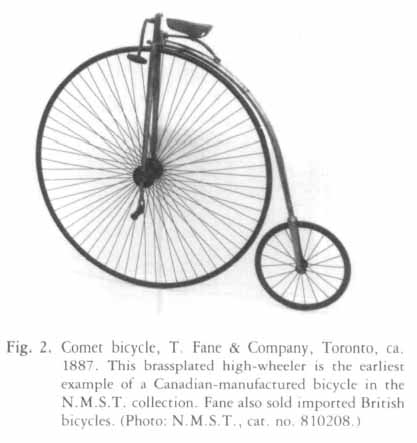 Display large image of Figure 2
Display large image of Figure 29 Research indicated that Canadian manufacturing began early in the history of cycling. Bicycles were reportedly built to order in the 1860s and 1870s; in the late 1860s, a homemade bicycle is said to have existed in Fredericton and, in 1878, seventeen-year-old Perry Doolittle, who was to become an avid cyclist and a founder of the Canadian Wheelman's Association, had a wooden bicycle built to his specifications.1 The first, or one of the first, Canadian manufacturers was Semmens, Ghent & Company, in Burlington, Ontario. As early as 1882, the company was producing nickel-plated or painted bicycles (presumably high-wheelers or ordinaries).2 Another early manufacturer was T. Fane & Company of Toronto. (Figure 2 is a Fane Comet ca. 1887.) By the late 1890s, at the peak of the boom, the industry mushroomed. Canadian companies (both Canadian-owned and American branch plants) and numerous individual bicyclemakers were producing the popular vehicles. After the boom subsided, manufacturing continued, generally of racing bicycles and, toward the middle of the twentieth century, of children's bicycles and tricycles. In the 1970s, the second boom occurred, sparking another expansion in manufacturing. Mass-produced racing, touring, BMX (bicycle motorcross), and mountain bicycles co-existed with sophisticated custom-made bicycles built by specialized workshops.
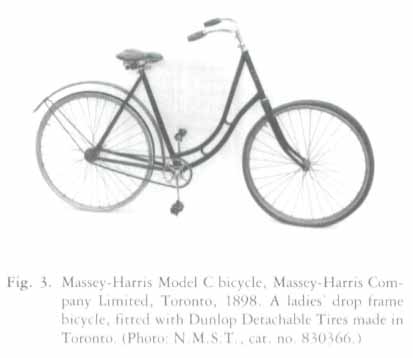 Display large image of Figure 3
Display large image of Figure 310 The bicycle industry in Canada consistently emerged as a consumer of foreign Technology. For example, Massey-Harris bicycles, produced from 1895 to 1899, used patents for the Columbia bicycle held by the Pope Manufacturing Company of Hartford, Connecticut.3 (See Figure 3 for an 1898 Massey-Harris lady's bicycle.) Arthur Pequegnat, a Berlin, Ontario, clock- and bicyclemaker, studied bicycle manufacturing techniques at the Middletown, Ohio, factory of the Miami Cycle and Manufacturing Company.4 (Figure 4 is a Pequegnat Berlin bicycle.) In the 1970s, Quebec custom bicyclemaker Giuseppe Marinoni travelled to Italy to observe master craftsmen at work.5 Branch plants, established by American companies to circumvent high Canadian tariff barriers, were significant producers in the turn-of-the-century Canadian industry. H.A. Lozier & Company, Toronto Junction, E.C. Stearns & Company, Toronto, and the National Cycle and Automobile Company, Hamilton, were among the better known late-nineteenth-century companies with heavy foreign ties. More recently, the now defunct Sekine Canada Ltd. was initially three-quarters Japanese-owned.6 Raw materials have also been imported. English-made steel tubing, like the modem Reynolds 531, has consistently been regarded as an industrial leader. Components, such as hubs, saddles, and brakes, have traditionally been produced abroad in large quantities by cost-efficient foreign companies. The CCM bicycle in Figure 5 features a number of Italian-made parts, including the world-famous Campagnolo components.
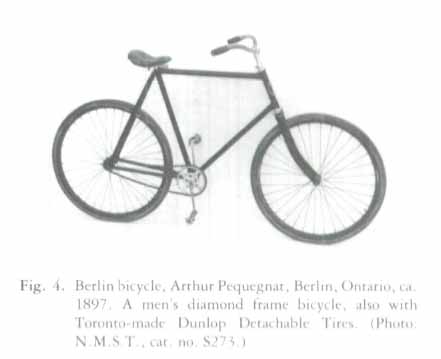 Display large image of Figure 4
Display large image of Figure 411 To a far lesser degree, Canada has been an exporter. In the early 1900s, Industrial Canada periodically contained trade enquiries from British firms seeking supplies of wooden bicycle rims. The Bowmanville Wood Rim Company, Bowmanville, Ontario, claimed to be producing 600 rims each day in 1897 in order to meet English orders.7 Canada Cycle and Motor Company (later CCM) sold its bicycles abroad soon after its formation in 1899-Australia and South Africa were important markets; for a time, the company also maintained agents in Europe.
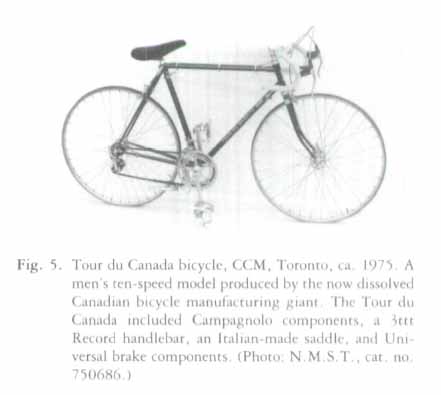 Display large image of Figure 5
Display large image of Figure 512 Participants in the industry have ranged from small-scale owner-operated businesses to industrial giants like CCM, which had over 1,000 employees in its bicycle and sporting goods divisions by the late 1970s. This variety in size of businesses has been a persistent feature of the industry. It characterized the turn of the century, when individual machinists and large companies like Massey-Harris produced bicycles, and was typical of the 1970s, with custom-made bicycles being produced by individual entrepreneurs at the same time that CCM produced its bicycles in large volumes.
13 Research also revealed that systems of manufacturers exist, based on the raw materials used in production. Bicycles were produced by machinists, agricultural implement manufacturers, a safe manufacturer, and a clock manufacturer, all of whom used metal extensively in their original lines of production. C.T.I, tended to note manufacturers of metal bicycle components in its bicycle parts listings to the virtual exclusion of rubber products, especially bicycle tires. To identify manufacturers of bicycle clothing or items used in bicycle maintenance, different sections of trade directories must be consulted, if indeed data are finely defined enough to uncover bicycle-related products. To some extent, the fragmentation of information about manufacturers in cycling and related industries in C.T.I, is a function of specialized production by use of specific raw materials.
14 This project is part of ongoing research on cycles at N.M.S.T. For further information on the material accumulated in this study, contact Geoff Rider, Curatorial, Conservation and Research Division, National Museum of Science and Technology, 2380 Lancaster Road, Ottawa, Ontario K1A 0M8, (613) 998-4566.